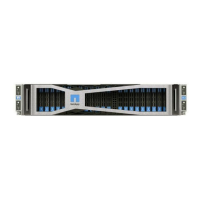Migrating from management node version 10.x to 11.x
If you have a management node at version 10.x, you cannot upgrade from 10.x to 11.x. You can instead use
this migration procedure to copy over the configuration from 10.x to a newly deployed 11.1 management node.
If your management node is currently at 11.0 or higher, you should skip this procedure. You need management
node 11.0 or 11.1 and the latest HealthTools to upgrade Element software from 10.3 + through 11.x.
Steps
1. From the VMware vSphere interface, deploy the management node 11.1 OVA and power it on.
2. Open the management node VM console, which brings up the terminal user interface (TUI).
3. Use the TUI to create a new administrator ID and assign a password.
4. In the management node TUI, log in to the management node with the new ID and password and validate
that it works.
5. From the vCenter or management node TUI, get the management node 11.1 IP address and browse to the
IP address on port 9443 to open the management node UI.
https://<mNode 11.1 IP address>:9443
6. In vSphere, select NetApp Element Configuration > mNode Settings. (In older versions, the top-level
menu is NetApp SolidFire Configuration.)
7. Click Actions > Clear.
8. To confirm, click Yes. The mNode Status field should report Not Configured.
When you go to the mNode Settings tab for the first time, the mNode Status field might
display as Not Configured instead of the expected UP; you might not be able to choose
Actions > Clear. Refresh the browser. The mNode Status field will eventually display
UP.
9. Log out of vSphere.
10. In a web browser, open the management node registration utility and select QoSSIOC Service
Management:
https://<mNode 11.1 IP address>:9443
11. Set the new QoSSIOC password.
The default password is solidfire. This password is required to set the new
password.
12. Click the vCenter Plug-in Registration tab.
13. Select Update Plug-in.
14. Enter required values. When you are finished, click UPDATE.
15. Log in to vSphere and select NetApp Element Configuration > mNode Settings.
16. Click Actions > Configure.

